Gold, Silver, Precious Metals Market Risk Reward Ratio
Commodities / Gold and Silver 2010 Jul 02, 2010 - 10:01 AM GMT At times daily volatility can cause one to lose the big picture from sight - focusing on trees is ok as far as one doesn't forget about the whole forest. This universal approach can be applied today since we have just seen a massive decline in the prices of gold, silver, and mining stocks. In this case, we would like to provide you with our thoughts on something that might influence the precious metals sector (not every part thereof to the same extent) - the head-and-shoulders formation on the general stock market (charts courtesy of http://stockcharts.com.)
At times daily volatility can cause one to lose the big picture from sight - focusing on trees is ok as far as one doesn't forget about the whole forest. This universal approach can be applied today since we have just seen a massive decline in the prices of gold, silver, and mining stocks. In this case, we would like to provide you with our thoughts on something that might influence the precious metals sector (not every part thereof to the same extent) - the head-and-shoulders formation on the general stock market (charts courtesy of http://stockcharts.com.)
Let's begin with the long-term SPY ETF chart.
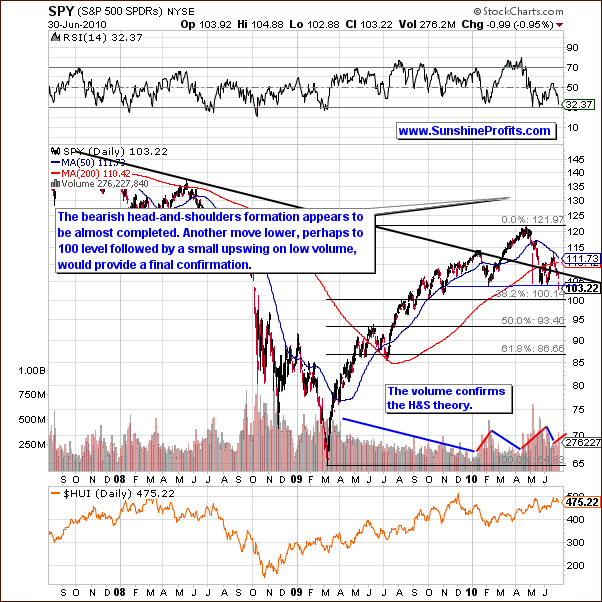
This week’s SPY chart clearly shows a continuation of the bearish trends, which were prevalent to last week. There has been continued development of the head-and-shoulders pattern and this has been confirmed by an increase in volume. The long-term chart above suggests that the pattern has yet to complete.
Note the low point is below two previous bottoms. Also, note the pattern in the chart of weekly volume levels. This bearish head-and-shoulders formation has and will probably continue to spell trouble for the general stock market. More details will be seen on the short-term charts.
The final confirmation of pattern completion will likely come from price movement in the SPY ETF or directly from the main stock indices such as the Dow Jones Industrial Average. Visible declining below the neck level (SPY: $103) and then increasing only slightly, accompanied by low volume increase would be a final confirmation of the bearish trend. Subscribers who seek to short the general stock market may wish to watch these signals closely as there may well be some good profit opportunities in this speculative activity.
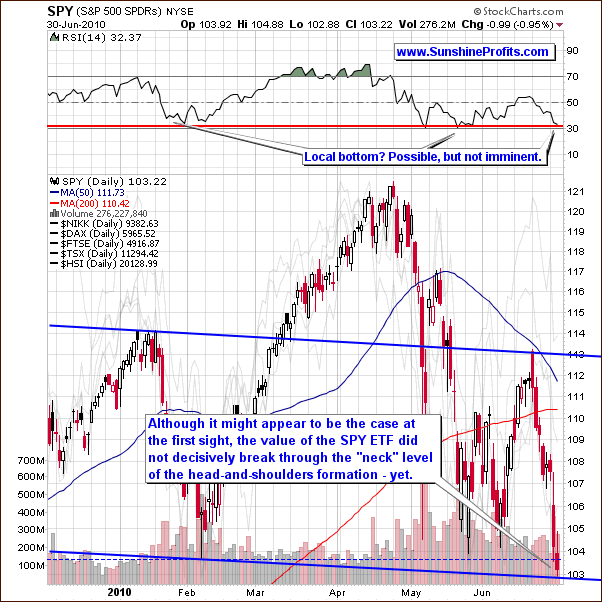
This week’s short-term chart reveals that the June top is slightly below the one seen during in January. Since the right shoulder in the pattern is lower than the left, the neck is likely skewed as well.
The price would need to move below the solid blue line in the chart for completion of the formation. Without this type of movement, the breakdown is not complete although it may appear to be.
The RSI is presently in the 30 range, which corresponded to local bottoms in early May and February. However the late January RSI in this range did not result in a local bottom until a week later. In late May the 30 level in RSI did not mark the final bottom either.
Consequently, the RSI alone does not imply that the bottom is imminent. If price were to move sideways and then lower or simply move lower immediately the implications would likely result in the SPY ETF below a level of $103 and then moving up on low volume would be a bearish signal.
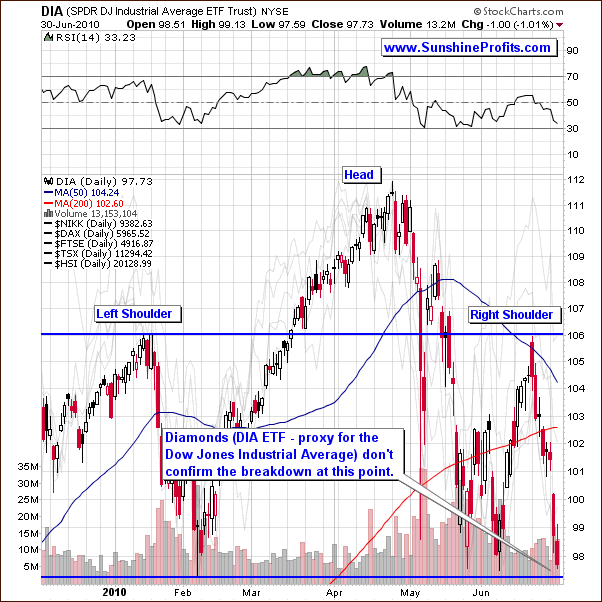
The DIA ETF, a proxy for the Dow Jones Industrial Average confirms the above comments about the non-existence of the breakdown at this point. The left and right shoulders are relatively equal - no breakdown has yet been seen here.
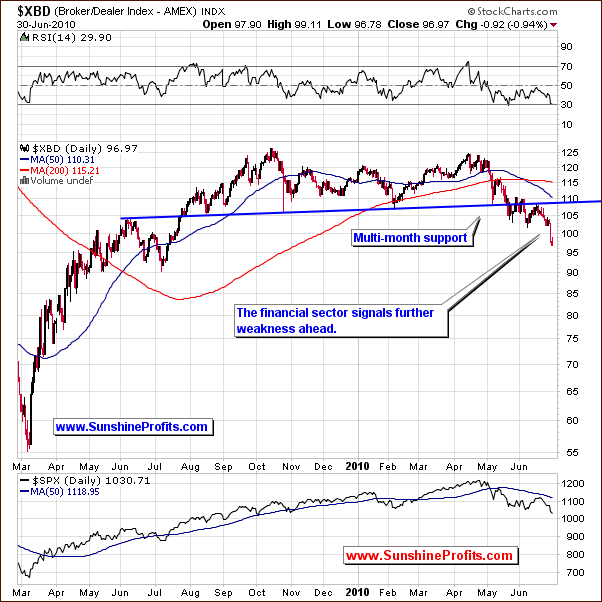
The Broker-Dealer Index this week indicates the likelihood of a breakdown. The financials have been very weak for several months and especially in recent days. This is normally a clear indication that declines will follow in the main stock indices.
Consequently, the odds favor a breakdown from the recent head and shoulders pattern in a continued move downward. Although this is not a certainty, it is probable. If the general stock market moves below the neck in this pattern and then rises slightly on low volume, shorting SPY ETF could be profitable. Part of the precious metals sector, namely silver and mining stocks are at particular risk when the general stock market is trending in ways seen today.
We have frequently commented on comparisons between gold and silver investments. While writing about gold being preferred over silver we have meant much more than just the profit potential of both markets. It simply indicated that silver and mining stocks are more vulnerable to general stock market's weakness and therefore carry a higher probability of not moving higher. This can also be stated as a higher risk to reward ratio.
Caution: the following is an example to be used only for illustrative purposes. The quantities, percentages and dollar amounts quoted are not in any way implied to be meaningful except in explaining the risk to reward ratio.
Let us say, for example, that gold has a 90% likelihood of increasing in price, silver has a 70% chance and mining stocks have a 60% chance and all of these markets would move up or down by the same amount during the move. All would be likely to move higher since, in this example, all percentages are greater than 50. Since gold is the most probable to go higher, it would be less risky. Therefore, gold would be preferable over silver and mining stocks even if all of them are likely to rise.
To address the subject of risk to reward ratio, let us go a step further with our previous illustration. Suppose that we invested $1,000 in each of the situations above. Let us further hypothesize that the upside potential or likely profits were $400 for each if our investments all reached their full potential.
The likely gain, or reward, would be $360 for gold since there is a 90% chance of the $400 profit, $280 for silver which has a 70% chance of the $400 profit, and $240 for mining stocks. Since the risk for each was the investment of $1,000, the risk reward ratios would be 2.50, $1,000 divided by $360, 3.57, $1,000 divided by $280 and 4.20, $1,000 divided by $240 respectively. The statement gold has a lower risk-to-reward ratio that the other precious metals is thus supported by this example.
Another example: gold has a 90% likelihood of rising 10% higher (and if it moves lower, it would move 10% lower), silver has 90% likelihood of rising 11% higher (and if it moves lower it would move 50% lower). Which of them has the better risk/reward ratio? Gold - because even with higher profit potential for silver (11% vs. 10%) the real difference is what happens if the move up does not materialize at all (only 10% probability). In this case gold investor loses 10%, while silver investor loses 50%. We get the feeling that at this point you would have preferred to own gold instead of silver even though it had smaller profit potential. Of course, you cannot go back in time, so you need to take the negative outcome into consideration before you put your money on the table. In this case it would mean buying gold instead of silver even though it was likely to gain less during an upswing. Moreover, those who invested in silver could brag about their higher profits not mentioning the fact that they were risking 50% of their money, while gold investors only risked 10%.
Let's run a simple simulation for the above example. Speculation is not a one-time bet - it's a set of many bets, and what matters is if you lose or gain money in the long run. So, let's see what would happen if there were many similar situations to the one described above.
With 10% of losing and 20 trades the average value of losing trades would equal 2, so we would have on average 18 winning trades and 2 losing ones.
For 20 trades with the abovementioned odds and gains/losses the gold investor would gain 1.10*1.10*1.10*…*1.10*0.9*0.9 (18 times winning 10% and 2 times losing 10%). So, in the end the effect would be 1.10^18 * 0.9^2 - 1 = 3.50 meaning that the investor would gain 350% of their initial capital.
At the same time with the abovementioned odds and gains/losses, the silver investors would gain 1.11*1.11*1.11*…*1.11*0.5*0.5 (18 times winning 11% and 2 times losing 50%). So, in the end the effect would be 1.11^18 * 0.5^2 - 1 = 0.64 meaning that the investor would gain 64% of their initial capital.
Shocking isn't it? One could achieve over 5 times bigger profits just by paying attention to the "what if we're wrong" question. Moreover, if the gains and losses were spread evenly, the first loss would occur after 9 winning trades. Please recall that the profit potential alone was bigger for silver, meaning that if we had only winning trades one would have biggest gains by investing in this particular market. The point here is that up to this tenth trade gold investor would have smaller gains than his silver colleague, and the latter might argue that paying attention to losses makes no sense if markets are moving only up, and that the gold investor is wrong for preferring the yellow metal over the white one. The silver investor would have no idea that after his next trade he will wish that he had joined his golden colleague in the first place.
Please note that the above situation is just an example, in the future it could be the case that the risk/reward for silver is more profitable that the one present on the gold market.
Consequently, we strongly believe that the risk/reward ratio with focus on the long-term growth of one's portfolio is the most profitable way to approach any market, and that paying attention many factors instead of looking at the day-to-day gains will eventually prove very useful. Please keep the above examples in mind while examining the correlations matrix below.
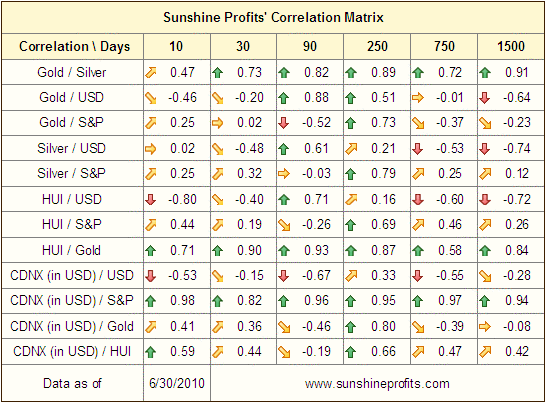
The correlation matrix has some changes this week. The positive relationship for silver and mining stocks with the general stock market has declined somewhat. The corresponding coefficient for gold with the general stock market still remains lower than the other metals. What this means is that gold will generally be more resilient during a downswing in the main stock indices; it will most likely hold its value more so than silver and precious metals' stocks.
Summing up, gold itself continues to be the preferred part of the precious metals sector at this point due to the tense situation on the general stock market. Meanwhile, we have just sent out a Market Alert to our Subscribers describing short- and long-term implications of yesterday's downswing for Precious Metals Investors and Traders.
To make sure that you are notified once the new features are implemented, and get immediate access to my free thoughts on the market, including information not available publicly, I urge you to sign up for my free e-mail list. Sign up today and you'll also get free, 7-day access to the Premium Sections on my website, including valuable tools and charts dedicated to serious PM Investors and Speculators. It's free and you may unsubscribe at any time.
Thank you for reading. Have a great and profitable week!
P. Radomski
Editor
Sunshine Profits
Interested in increasing your profits in the PM sector? Want to know which stocks to buy? Would you like to improve your risk/reward ratio?
Sunshine Profits provides professional support for precious metals Investors and Traders.
Apart from weekly Premium Updates and quick Market Alerts, members of the Sunshine Profits’ Premium Service gain access to Charts, Tools and Key Principles sections. Click the following link to find out how many benefits this means to you. Naturally, you may browse the sample version and easily sing-up for a free trial to see if the Premium Service meets your expectations.
All essays, research and information found above represent analyses and opinions of Mr. Radomski and Sunshine Profits' associates only. As such, it may prove wrong and be a subject to change without notice. Opinions and analyses were based on data available to authors of respective essays at the time of writing. Although the information provided above is based on careful research and sources that are believed to be accurate, Mr. Radomski and his associates do not guarantee the accuracy or thoroughness of the data or information reported. The opinions published above belong to Mr. Radomski or respective associates and are neither an offer nor a recommendation to purchase or sell securities. Mr. Radomski is not a Registered Securities Advisor. Mr. Radomski does not recommend services, products, business or investment in any company mentioned in any of his essays or reports. Materials published above have been prepared for your private use and their sole purpose is to educate readers about various investments.
By reading Mr. Radomski's essays or reports you fully agree that he will not be held responsible or liable for any decisions you make regarding any information provided in these essays or reports. Investing, trading and speculation in any financial markets may involve high risk of loss. We strongly advise that you consult a certified investment advisor and we encourage you to do your own research before making any investment decision. Mr. Radomski, Sunshine Profits' employees and affiliates as well as members of their families may have a short or long position in any securities, including those mentioned in any of the reports or essays, and may make additional purchases and/or sales of those securities without notice.
Przemyslaw Radomski Archive |
© 2005-2022 http://www.MarketOracle.co.uk - The Market Oracle is a FREE Daily Financial Markets Analysis & Forecasting online publication.
Comments
|
Jake
05 Jul 10, 04:13 |
Thanks
Thanks for this article. It helped me to keep my eyes on target. |



